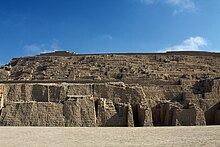Pachacámac is an archaeological site 40 kilometres (25 mi) southeast of Lima, Peru in the Valley of the Lurín River. The site was first settled around A.D. 200 and was named after the "Earth Maker" creator god Pacha Kamaq. The site flourished for about 1,300 years until the Spanish invaded. Pachacamac covers about 600 hectares of land.
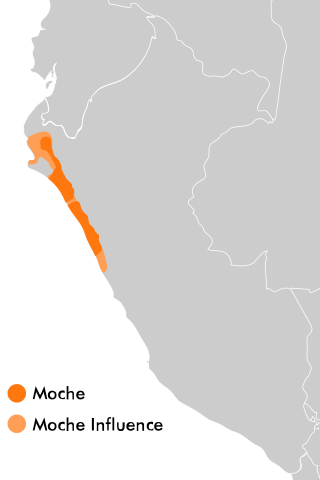
The Moche civilization flourished in northern Peru with its capital near present-day Moche, Trujillo, Peru from about 100 to 700 AD during the Regional Development Epoch. While this issue is the subject of some debate, many scholars contend that the Moche were not politically organized as a monolithic empire or state. Rather, they were likely a group of autonomous polities that shared a common culture, as seen in the rich iconography and monumental architecture that survives today.

In the Quechuan languages of South America, a huaca or wak'a is an object that represents something revered, typically a monument of some kind. The term huaca can refer to natural locations, such as immense rocks. Some huacas have been associated with veneration and ritual. The Quechua people traditionally believed every object has a physical presence and two camaquen (spirits), one to create it and another to animate it. They would invoke its spirits for the object to function.
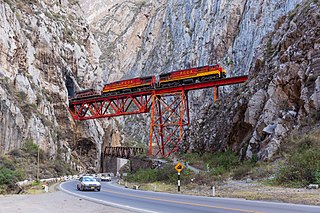
The Department of Lima is a department and region located in the central coast of Peru; the seat of the regional government is Huacho.

Chimor was the political grouping of the Chimú culture. The culture arose about 900 CE, succeeding the Moche culture, and was later conquered by the Inca emperor Topa Inca Yupanqui around 1470, fifty years before the arrival of the Spanish in the region. Chimor was the largest kingdom in the Late Intermediate Period, encompassing 1,000 kilometres (620 mi) of coastline.

The Huaca del Sol is an adobe brick pyramid built by the Moche civilization on the northern coast of what is now Peru. The pyramid is one of several ruins found near the volcanic peak of Cerro Blanco, in the coastal desert near Trujillo at the Moche Valley. The other major ruin at the site is the nearby Huaca de la Luna, a better-preserved but smaller temple.

Huaca Rajada, also known as Sipán, is a Moche archaeological site in northern Peru in the Lambayeque Valley, that is famous for the tomb of Lord of Sipán, excavated by Walter Alva and his wife Susana Meneses beginning in 1987. The city of Sipán is dated from 50–700 AD, the same time as the Moche Period.

The Lord of Sipán is the name given to the first of several Moche mummies found at Huaca Rajada, Sipán, Peru by archaeologist Walter Alva. The site was discovered in 1987.

Located in the Chicama Valley, the El Brujo Archaeological Complex, just north of Trujillo, La Libertad Province, Peru, is an ancient archaeological site that was occupied from preceramic times. Considering the broad cultural sequencing, the Chicama Valley can be considered as an archaeological microcosm. Research at the site benefits from the favourable environmental and topological conditions for material conservation.
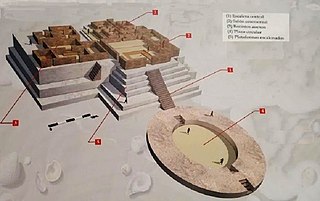
Aspero is a well-studied Late Preceramic site archaeological complex located near the mouth of the Supe River, south of Supe Puerto, on the central coast of Peru. It forms part of the ancient Caral-Supe civilization and was occupied during the Late Archaic period, from before 3000 BCE to around 1800 BCE. It is connected culturally to the ancient city of Caral, located 25 km up-valley, for which it presumably served as a major fishery. The site covers an area of approximately 14 hectares and features numerous temples or huacas, of which the most prominent are the Huaca Alta, the Huaca de los ídolos and the Huaca de los Sacrificios. Remains of human sacrifice have been found in the latter, dated to about 4500 years ago.
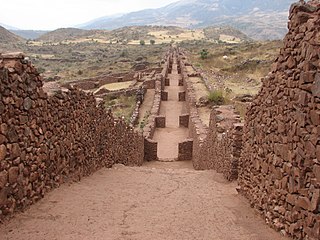
Pikillaqta is a large Wari culture archaeological site 20 kilometres (12 mi) east of Cusco in the Quispicanchi Province.

Ventarrón is the site of a 4,500-year-old temple with painted murals, which was excavated in Peru in 2007 near Chiclayo, in the Lambayeque region on the northern coast. The site was inhabited by the Early Cupisnique, Cupisnique, Chavin and Moche cultures.

The Lima culture was an indigenous civilization which existed in modern-day Lima, Peru during the Early Intermediate Period, extending from roughly 100 to 650. This pre-Incan culture, which overlaps with surrounding Paracas, Moche, and Nasca civilizations, was located in the desert coastal strip of Peru in the Chillon, Rimac and Lurin River valleys. It can be difficult to differentiate the Lima culture from surrounding cultures due to both its physical proximity to other, and better documented cultures, in Coastal Peru, and because it is chronologically very close, if not over lapped, by these other cultures as well. These factors all help contribute to the obscurity of the Lima culture, of which much information is still left to be learned.
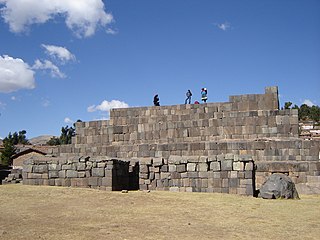
An ushnu or usnu is a pyramid-shaped, terraced structure that was used by the Inca to preside at the most important ceremonies of the Tawantinsuyu, or Inca Empire.

La Campana is an archaeological site included in the Mexican archaeological heritage list since 1917. Located in the vicinity of the city of Colima. This site was the largest prehispanic population center in western Mexico. Site studies indicate that some of its features are related to the classical period Teotihuacan culture.

Ichma, Ychma, Yschma, Ychsma, Ichmay, Irma, Izma, Ishmay or Ishma was a pre-Inca indigenous polity later absorbed by the Inca Empire and reorganized as a wanami (province). For the Inca it was known as Pachakamaq (Pachacamac), rather than its original name of Ishma.
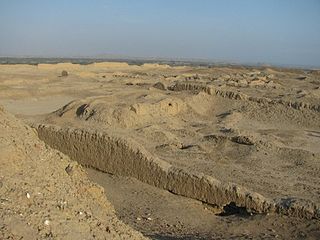
The Pacatnamu site is located at the mouth of the Jequetepeque Valley on the northern coast of Peru. Rocky cliffs protect two of its sides and a humanmade wall protects the third. This area of Peru does not have a tropical environment; it gets very little precipitation and has a mild climate, which sometime can become very humid.
The Chotuna Chornancap Archaeological Complex is an archaeological site in San Jose district, Lambayeque Region, 12 kilometres (7.5 mi) north-west of Chiclayo, Peru of a set of truncated pyramids and compounds, highlighting two pyramids: Chotuna and Chornancap, the first of them believed to be related to the legend of Naylamp. Chotuna was a ceremonial center of the Sican culture, one of the cultures of Pre-Columbian Peru, which developed between the years 700 to 1300 AD. Later the Chimu and then the Inca occupation followed. In 2011 the tomb of the so-called priestess of Chornancap was discovered.

A huanca or chichic (tsitsiq) is an elongated vertical stone considered sacred, with multiple symbolisms, in the Andean worldview. Huancas were worshipped and given rituals and offerings. The stone placed at the top is called chacrayoc;.
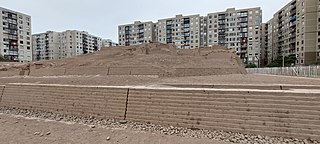
The Huaca Huantinamarca is an archaeological site of the Ichma culture located in San Miguel District, in Lima, Peru. It is located on the first block of the Avenue Brígida Silva de Ochoa.
